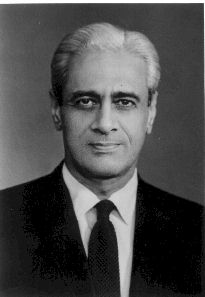Satish Dhawan facts for kids
Quick facts for kids
Satish Dhawan
|
|
|---|---|
 |
|
| Born | 25 September 1920 |
| Died | 3 January 2002 (aged 81) |
| Alma mater | |
| Known for | Indian space programme |
| Awards | Padma Bhushan(1971) Padma Vibhushan(1981) |
| Scientific career | |
| Fields | Mechanical and aerospace Engineering |
| Institutions | Indian Space Research Organisation Indian Institute of Science California Institute of Technology National Aerospace Laboratories |
| Thesis | Direct Measurements of Skin Friction (1951) |
| Doctoral advisor | Hans W. Liepmann |
| Signature | |
 |
|
|
Satish Dhawan
|
|
|---|---|
| Chairman, ISRO | |
| In office 1972–1984 |
|
| Preceded by | M. G. K. Menon |
| Succeeded by | Udupi Ramachandra Rao |
Satish Dhawan (born September 25, 1920 – died January 3, 2002) was a brilliant Indian mathematician and aerospace engineer. He is often called the father of research into how fluids (like air and water) move in India. He was born in Srinagar.
Dhawan studied in both India and the United States. He was a top expert in areas like turbulence (swirling, unpredictable fluid motion) and boundary layers (the thin layer of fluid close to a surface). His work helped greatly in creating India's own space program. In 1972, he became the third chairman of the Indian Space Research Organisation (ISRO). The Satish Dhawan Space Centre, which is a major launch site for rockets, is named after him. Many people see him as a mentor to A. P. J. Abdul Kalam, who later became India's president.
Contents
Early Life and Family
Satish Dhawan was born into a Punjabi family. His father, Rai Bahadur Devi Dayal Dhawan, was a smart man who studied science and law. He later became a judge.
His Amazing Education
Dhawan went to several important colleges. He studied physics, mathematics, and mechanical engineering at what is now Punjab Engineering College in Chandigarh. He also earned a Master of Arts degree in English literature!
In 1947, he went to the United States. He got a Master of Science degree in aerospace engineering from the University of Minnesota. Then, he studied at the California Institute of Technology. There, he earned two PhDs in 1951: one in mathematics and another in aerospace engineering. His advisor was a famous scientist named Hans W. Liepmann.
Leading India's Space Program
In 1972, Satish Dhawan became the chairman of the Indian Space Research Organisation (ISRO). He also became a secretary to the Government of India for the Department of Space.
APJ Abdul Kalam shared an important story about Dhawan's leadership. In 1979, Kalam was in charge of a mission to launch a satellite. The mission failed, and the satellite fell into the Bay of Bengal. Kalam's team knew there was a small fuel leak, but they hoped it wouldn't matter. This mistake caused the failure.
Satish Dhawan, as the chairman, called Abdul Kalam. Then, he spoke to the press and said, "We failed! But I have strong trust in my team, and I believe that next time we will definitely succeed." This surprised Abdul Kalam. Dhawan took all the blame for the failure himself.
The team worked hard, and the next mission in 1980 was a big success! This time, Satish Dhawan told Abdul Kalam to attend the press conference alone. Dhawan showed that a true leader takes the blame when things go wrong but gives all the credit to the team when they succeed.
Satish Dhawan led ISRO until 1984.
Director at IISc
From 1962 to 1981, Dhawan was the director of the Indian Institute of Science (IISc) in Bangalore. Even while leading India's space program, he spent a lot of time researching boundary layers. These are thin layers of fluid (like air) that stick to the surface of an object moving through it. His work is mentioned in a very important book called Boundary Layer Theory.
He also built India's first supersonic wind tunnel at IISc. This tunnel helps scientists study how things fly faster than the speed of sound. He also did new research on how boundary layers behave in different situations.
Boosting Space Research
Satish Dhawan helped start important projects in rural education, remote sensing (using satellites to gather information about Earth), and satellite communications. His efforts led to successful systems like:
- INSAT: A satellite system for telecommunications, like TV and phone calls.
- IRS: Satellites that take pictures and collect data about Earth from space.
- Polar Satellite Launch Vehicle (PSLV): A powerful rocket that can launch satellites into orbit.
These achievements helped India become one of the leading spacefaring nations in the world.
Honours and Recognition
Satish Dhawan passed away on January 3, 2002, in Bangalore. To honor his great contributions, the main satellite launch center in Sriharikota, Andhra Pradesh, was renamed the Satish Dhawan Space Centre after his death. Other places, like the Satish Chander Dhawan Government College For Boys in Ludhiana and a building at the IIT Ropar, are also named after him.
His Important Roles
-
- Senior Scientific Officer, 1951
- Professor and Head of Aeronautical Engineering, 1955
- Director, 1962–1981
-
- Visiting Professor, 1971–72
- National Aerospace Laboratories, Bangalore
-
- Chairman, Research Council, 1984–93
- Indian Academy of Sciences
-
- President, 1977–1979
-
- Chairman, 1972–1984
- Indian Space Commission
-
- Chairman, 1972–2002
Awards He Received
- Padma Vibhushan (India's second highest civilian honor), 1981
- Padma Bhushan (India's third highest civilian honor), 1971
- Indira Gandhi Award for National Integration, 1999
- Distinguished Alumnus Award, Indian Institute of Science
- Distinguished Alumnus Award, California Institute of Technology, 1969
His Personal Life
Satish Dhawan was born on September 25, 1920, in Srinagar. His family was from Dera Ismail Khan. He grew up in Lahore and Kashmir. He was married to Nalini Dhawan, who was a scientist studying genetics. His daughter, Jyotsna Dhawan, is also a senior scientist today.
Images for kids


